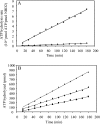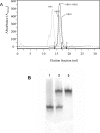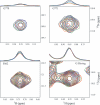Attempts to characterize the NBD heterodimer of MRP1: transient complex formation involves Gly771 of the ABC signature sequence but does not enhance the intrinsic ATPase activity
- PMID: 16014004
- PMCID: PMC1276949
- DOI: 10.1042/BJ20050897
Attempts to characterize the NBD heterodimer of MRP1: transient complex formation involves Gly771 of the ABC signature sequence but does not enhance the intrinsic ATPase activity
Abstract
MRP1 (multidrug-resistance-associated protein 1; also known as ABCC1) is a member of the human ABC (ATP-binding cassette) transporter superfamily that confers cell resistance to chemotherapeutic agents. Considering the structural and functional similarities to the other ABC proteins, the interaction between its two NBDs (nucleotide-binding domains), NBD1 (N-terminal NBD) and NBD2 (C-terminal NBD), is proposed to be essential for the regulation of the ATP-binding/ATP-hydrolysis cycle of MRP1. We were interested in the ability of recombinant NBD1 and NBD2 to interact with each other and to influence ATPase activity. We purified NBD1 (Asn642-Ser871) and NBD2 (Ser1286-Val1531) as soluble monomers under native conditions. We measured extremely low intrinsic ATPase activity of NBD1 (10(-5) s(-1)) and NBD2 (6x10(-6) s(-1)) and no increase in the ATP-hydrolysis rate could be detected in an NBD1+NBD2 mixture, with concentrations up to 200 microM. Despite the fact that both monomers bind ATP, no stable NBD1.NBD2 heterodimer could be isolated by gel-filtration chromatography or native-PAGE, but we observed some significant modifications of the heteronuclear single-quantum correlation NMR spectrum of 15N-NBD1 in the presence of NBD2. This apparent NBD1.NBD2 interaction only occurred in the presence of Mg2+ and ATP. Partial sequential assignment of the NBD1 backbone resonances shows that residue Gly771 of the LSGGQ sequence is involved in NBD1.NBD2 complex formation. This is the first NMR observation of a direct interaction between the ABC signature and the opposite NBD. Our study also reveals that the NBD1.NBD2 heterodimer of MRP1 is a transient complex. This labile interaction is not sufficient to induce an ATPase co-operativity of the NBDs and suggests that other structures are required for the ATPase activation mechanism.
Figures






Similar articles
-
Biochemical characterization and NMR studies of the nucleotide-binding domain 1 of multidrug-resistance-associated protein 1: evidence for interaction between ATP and Trp653.Biochem J. 2003 Dec 15;376(Pt 3):749-56. doi: 10.1042/BJ20030998. Biochem J. 2003. PMID: 12954082 Free PMC article.
-
The Walker B motif of the second nucleotide-binding domain (NBD2) of CFTR plays a key role in ATPase activity by the NBD1-NBD2 heterodimer.Biochem J. 2007 Jan 15;401(2):581-6. doi: 10.1042/BJ20060968. Biochem J. 2007. PMID: 16989640 Free PMC article.
-
Characterization of the ATPase activity of a novel chimeric fusion protein consisting of the two nucleotide binding domains of MRP1.Arch Biochem Biophys. 2009 May 15;485(2):102-8. doi: 10.1016/j.abb.2009.03.003. Epub 2009 Mar 11. Arch Biochem Biophys. 2009. PMID: 19285030
-
Molecular basis for the ATPase activity of CFTR.Arch Biochem Biophys. 2008 Aug 1;476(1):95-100. doi: 10.1016/j.abb.2008.03.033. Epub 2008 Apr 8. Arch Biochem Biophys. 2008. PMID: 18417076 Review.
-
Structure of multidrug-resistance proteins of the ATP-binding cassette (ABC) superfamily.Curr Med Chem Anticancer Agents. 2004 Jan;4(1):53-62. doi: 10.2174/1568011043482160. Curr Med Chem Anticancer Agents. 2004. PMID: 14754412 Review.
Cited by
-
The nucleotide-binding domain 2 of the human transporter protein MRP6.J Bioenerg Biomembr. 2011 Oct;43(5):465-71. doi: 10.1007/s10863-011-9372-5. Epub 2011 Jul 12. J Bioenerg Biomembr. 2011. PMID: 21748403
-
Divergent signature motifs of nucleotide binding domains of ABC multidrug transporter, CaCdr1p of pathogenic Candida albicans, are functionally asymmetric and noninterchangeable.Biochim Biophys Acta. 2010 Sep;1798(9):1757-66. doi: 10.1016/j.bbamem.2010.05.017. Epub 2010 May 28. Biochim Biophys Acta. 2010. PMID: 20546701 Free PMC article.
-
Interaction of asymmetric ABCC9-encoded nucleotide binding domains determines KATP channel SUR2A catalytic activity.J Proteome Res. 2008 Apr;7(4):1721-8. doi: 10.1021/pr7007847. Epub 2008 Mar 1. J Proteome Res. 2008. PMID: 18311911 Free PMC article.
-
Characterization of the nucleotide-binding domain NsrF from the BceAB-type ABC-transporter NsrFP from the human pathogen Streptococcus agalactiae.Sci Rep. 2020 Sep 16;10(1):15208. doi: 10.1038/s41598-020-72237-7. Sci Rep. 2020. PMID: 32938989 Free PMC article.
-
The ATPase activities of sulfonylurea receptor 2A and sulfonylurea receptor 2B are influenced by the C-terminal 42 amino acids.FEBS J. 2010 Jun;277(12):2654-62. doi: 10.1111/j.1742-464X.2010.07675.x. FEBS J. 2010. PMID: 20553499 Free PMC article.
References
-
- Holland B., Cole S. P., Kuchler K., Higgins C. F., editors. London: Academic Press; 2003. ABC Proteins from Bacteria to M.
-
- Hipfner D. R., Deeley R. G., Cole S. P. Structural, mechanistic and clinical aspects of MRP1. Biochim. Biophys. Acta. 1999;1461:359–376. - PubMed
-
- Cole S. P., Bhardwaj G., Gerlach J. H., Mackie J. E., Grant C. E., Almquist K. C., Stewart A. J., Kurz E. U., Duncan A. M., Deeley R. G. Overexpression of a transporter gene in a multidrug-resistant human lung cancer cell line. Science. 1992;258:1650–1654. - PubMed
-
- Cole S. P., Deeley R. G. Multidrug resistance mediated by the ATP-binding cassette transporter protein MRP. BioEssays. 1998;20:931–940. - PubMed
-
- Leslie E. M., Deeley R. G., Cole S. P. Toxicological relevance of the multidrug resistance protein 1, MRP1 (ABCC1) and related transporters. Toxicology. 2001;167:3–23. - PubMed
MeSH terms
Substances
LinkOut - more resources
Full Text Sources
Research Materials

